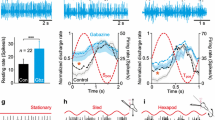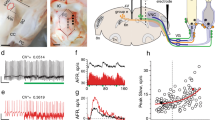Abstract
Axonal pathways, projection levels, and locations of horizontal semicircular canal (HC) nerve-activated vestibulospinal neurons were studied. The HC nerve was selectively stimulated. Vestibulospinal neurons were activated antidromically with four stimulating electrodes, inserted bilaterally into the lateral vestibulospinal tracts (LVST) and medial vestibulospinal tracts (MVST) at the C1/C2 junction. Stimulating electrodes were also positioned in the C3, T1, and L3 segments and in the oculomotor nuclei. Most HC nerve-activated vestibulospinal neurons were located in the ventral portion of the medial, lateral, and the descending nuclei. Among the 157 HC nerve-activated vestibular neurons, 83 were antidromically activated by stimulation at the C1/C2 junction. Of these 83 neurons, axonal pathways of 56 HC nerve-activated vestibulospinal neurons were determined. Most (48/56) of these had axons that descended through the MVST, with the remainder (8 neurons) having axons that descended through the ipsilateral (i-) LVST. Laterality of the axons’ trajectories through the MVST was investigated. The majority of vestibulospinal neurons (24/28) with axons descending through the contralateral MVST were also antidromically activated from the oculomotor nucleus, whereas almost all vestibulospinal neurons (19/20) with axons descending through the i-MVST were not. Most HC nerve-activated vestibulospinal neurons were activated antidromically only from the C1/C2 or C3 segments. Only one neuron that was antidromically activated from the T1 segment had an axon that descended through the i-LVST. None of the HC nerve-activated vestibulospinal neurons were antidromically activated from the L3 segment. It is likely that the majority of HC nerve-activated vestibulospinal neurons terminate in the cervical cord and have strong connections with neck motoneurons.




Similar content being viewed by others
References
Abzug C, Maeda M, Peterson BW, Wilson VJ (1974) Cervical branching of lumbar vestibulospinal axons. J Physiol 243:499–522
Akaike T, Fanardjian VV, Ito M, Kumada M, Nakajima H (1973) Electrophysiological analysis of the vestibulospinal reflex pathway of rabbit. I. Classification of tract cells. Exp Brain Res 17:477–496
Baker R, Highstein SM (1978) Vestibular projections to medial rectus subdivision of oculomotor nucleus. J Neurophysiol 41:1629–1646
Boyle R, Goldberg JM, Highstein SM (1992) Inputs from regularly and irregularly discharging vestibular nerve afferents to secondary neurons in squirrel monkey vestibular nuclei. III. Correlation with vestibulospinal and vestibuloocular output pathways. J Neurophysiol 68:471–484
Carleton SC, Carpenter MB (1983) Afferent and efferent connections of the medial, inferior and lateral vestibular nuclei in the cat and monkey. Brain Res 278:29–51
Ezure K, Graf W (1984a) A quantitative analysis of the spatial organization of the vestibulo-ocular reflexes in lateral- and frontal-eyed animals. I. Orientation of semicircular canals and extraocular muscles. Neuroscience 12:85–93
Ezure K, Graf W (1984b) A quantitative analysis of the spatial organization of the vestibulo-ocular reflexes in lateral- and frontal-eyed animals. II. Neuronal networks underlying vestibulo-oculomotor coordination. Neuroscience 12:95–109
Fukushima K, Peterson BW, Wilson VJ (1979) Vestibulospinal, reticulospinal and interstitiospinal pathways in the cat. In: Granit R, Pompeiano O (eds) Reflex control of posture and movement. Prog Brain Res vol 50. Elsevier/North-Holland Biomedical, Amsterdam, pp 121–136
Graf W, Gerrits N, Yatim-Dhiba N, Ugolini G (2002) Mapping the oculomotor system: the power of transneuronal labelling with rabies virus. Eur J Neurosci 15:1557–1562
Ishizuka N, Mannen H, Sasaki S-I, Shimazu H (1980) Axonal branches and terminations in the cat abducens nucleus of secondary vestibular neurons in the horizontal canal system. Neurosci Lett 16:143–148
Isu N, Yokota J (1983) Morphophysiological study on the divergent projection of axon collaterals of medial vestibular nucleus neurons in the cat. Exp Brain Res 53:151–162
Isu N, Uchino Y, Nakashima H, Satoh S, Ichikawa T, Watanabe S (1988) Axonal trajectories of posterior canal-activated secondary vestibular neurons and their coactivation of extraocular and neck flexor motoneurons in the cat. Exp Brain Res 70:181–191
Isu N, Sakuma A, Hiranuma K, Uchino H, Sasaki S-I, Imagawa M, Uchino Y (1991) The neuronal organization of horizontal semicircular canal activated inhibitory vestibulocollic neurons in the cat. Exp Brain Res 86:9–17
Ito M, Hongo T, Okada Y (1969) Vestibular-evoked postsynaptic potentials in Deiters’ neurones. Exp Brain Res 7:214–230
Kushiro K, Zakir M, Sato H, Ono S, Ogawa Y, Meng H, Zhang X, Uchino Y (2000) Saccular and utricular inputs to single vestibular neurons in cats. Exp Brain Res 131:406–415
Kuze B, Matsuyama K, Matsui T, Miyata H, Mori S (1999) Segment-specific branching patterns of single vestibulospinal tract axons arising from the lateral vestibular nucleus in the cat: a PHA-L tracing study. J Comp Neurol 414:80–96
Maeda M, Maunz RA, Wilson VJ (1975) Labyrinthine influence on cat forelimb motoneurons. Exp Brain Res 22:69–86
McCrea RA, Strassman A, May E, Highstein SM (1987) Anatomical and physiological characteristics of vestibular neurons mediating the horizontal vestibulo-ocular reflex of the squirrel monkey. J Comp Neurol 264:547–570
Minor LB, McCrea RA, Goldberg JM (1990) Dual projections of secondary vestibular axons in the medial longitudinal fasciculus to extraocular motor nuclei and the spinal cord of the squirrel monkey. Exp Brain Res 83:9–21
Nyberg-Hansen R, Mascitti TA (1964) Sites and mode of termination of fibers of the vestibulospinal tract in the cat. An experimental study with silver impregnation methods. J Comp Neurol 122:369–388
Ohgaki T, Curthoys IS, Markham CH (1988) Morphology of physiologically identified second-order vestibular neurons in cat, with intracellularly injected HRP. J Comp Neurol 276:387–411
Perlmutter SI, Iwamoto Y, Barke LF, Baker JF, Peterson BW (1998) Relation between axon morphology in C1 spinal cord and spatial properties of medial vestibulospinal tract neurons in the cat. J Neurophysiol 79:285–303
Peterson BW (1970) Distribution of neural responses to tilting within vestibular nuclei of the cat. J Neurophysiol 33:750–767
Petras JM (1967) Cortical, tectal and tegmental fiber connections in the spinal cord of the cat. Brain Res 6:275–324
Pompeiano O, Brodal A (1957) The origin of vestibulospinal fibres in the cat. An experimental-anatomical study, with comments on the descending medial longitudinal fasciculus. Arch Ital Biol 95:166–195
Precht W, Shimazu H (1965) Functional connections of tonic and kinetic vestibular neurons with primary vestibular afferents. J Neurophysiol 28:1014–1028
Rapoport S, Susswein A, Uchino Y, Wilson VJ (1977) Properties of vestibular neurones projecting to neck segments of the cat spinal cord. J Physiol 268:493–510
Sasaki K (1963) Electrophysiological studies on oculomotor neurons of the cat. Jap J Physiol 13:287–302
Sato H, Endo K, Ikegami H, Imagawa M, Sasaki M, Uchino Y (1996) Properties of the utricular nerve-activated vestibulospinal neurons in cats. Exp Brain Res 112:197–202
Sato H, Imagawa M, Isu N, Uchino Y (1997) Properties of saccular nerve-activated vestibulospinal neurons in cats. Exp Brain Res 116:381–388
Sato H, Imagawa M, Kushiro K, Zakir M, Uchino Y (2000) Convergence of posterior semicircular canal and saccular inputs in single vestibular nuclei neurons in cats. Exp Brain Res 131:253–261
Shinoda Y, Ohgaki T, Sugiuchi Y, Futami T (1989) Comparison of the branching patterns of lateral and medial vestibulospinal tract axons in the cervical spinal cord. Prog Brain Res 80:137–147
Shinoda Y, Sugiuchi Y, Futami T, Ando N, Kawasaki T (1994) Input patterns and pathways from the six semicircular canals to motoneurons of neck muscles. I. The multifidus muscle group. J Neurophysiol 72:2691–2702
Sugiuchi Y, Izawa Y, Shinoda Y (1995) Trisynaptic inhibition from the contralateral vertical semicircular canal nerves to neck motoneurons mediated by spinal commissural neurons. J Neurophysiol 73:1973–1987
Tarlov E (1970) Organization of vestibulo-oculomotor projections in the cat. Brain Res 20:159–179
Uchino Y, Hirai H (1984) Axon collaterals of anterior semicircular canal-activated vestibular neurons and their coactivation of extraocular and neck motoneurons in the cat. Neurosci Res 1:309–325
Uchino Y, Isu N (1992a) Properties of inhibitory vestibulo-ocular and vestibulo-collic neurons in the cat. In: Shimazu H, Shinoda Y (eds) Vestibular and brain stem control of eye, head and body movements. Japan Scientific Societies Press, Tokyo/Karger, Basel, pp 31–43
Uchino Y, Isu N (1992b) Properties of vestibulo-ocular and/or vestibulocollic neurons in the cat. In: Berthoz A, Graf W, Vidal PP (eds) The head-neck sensory motor system. Oxford University Press, New York, pp 266–272
Uchino Y, Suzuki S, Miyazawa T, Watanabe S (1979) Horizontal canal input to cat extraocular motoneurons. Brain Res 177:231–240
Uchino Y, Isu N, Ichikawa T, Satoh S, Watanabe S (1988) Properties and localization of the anterior semicircular canal-activated vestibulocollic neurons in the cat. Exp Brain Res 71:345–352
Uchino Y, Isu N, Sakuma A, Ichikawa T, Hiranuma K (1990a) Axonal trajectories of inhibitory vestibulocollic neurons activated by the anterior semicircular canal nerve and their synaptic effects on neck motoneurons in the cat. Exp Brain Res 82:14–24
Uchino Y, Sasaki S-I, Imagawa M, Uchino H, Isu N, Sakuma A (1990b) Properties and axonal trajectories of inhibitory vestibulocollic neurons in the horizontal canal system of the cat. Neurosci Res Suppl 11:S139
Uchino Y, Sato H, Sasaki M, Imagawa M, Ikegami H, Isu N, Graf W (1997) Sacculocollic reflex arcs in cats. J Neurophysiol 77:3003–3012
Wilson VJ, Felpel LP (1972) Specificity of semicircular canal input to neurons in the pigeon vestibular nuclei. J Neurophysiol 35:253–264
Wilson VJ, Maeda M (1974) Connections between semicircular canals and neck motoneurons in the cat. J Neurophysiol 37:346–357
Wilson VJ, Melvill Jones G (1979) The vestibulospinal system. Mammalian vestibular physiology. Plenum, New York, pp 185–248
Wilson VJ, Kato M, Peterson BW, Wylie RM (1967) A single-unit analysis of the organization of Deiters’ nucleus. J Neurophysiol 30:603–619
Zakir M, Kushiro K, Ogawa Y, Sato H, Uchino Y (2000) Convergence patterns of the posterior semicircular canal and utricular inputs in single vestibular neurons in cats. Exp Brain Res 132:139–148
Zhang X, Zakir M, Meng H, Sato H, Uchino Y (2001) Convergence of the horizontal semicircular canal and otolith afferents on cat single vestibular neurons. Exp Brain Res 140:1–11
Zhang X, Sasaki M, Sato H, Meng H, Bai R, Imagawa M, Uchino Y (2002) Convergence of the anterior semicircular canal and otolith afferents on cat single vestibular neurons. Exp Brain Res 147:407–417
Acknowledgements
We thank Ms K. Takayama for secretarial assistance. This study was supported by a research grant from the Japan Space Forum promoted by NASDA (National Space Development Agency of Japan).
Author information
Authors and Affiliations
Corresponding author
Rights and permissions
About this article
Cite this article
Sugita, A., Bai, R., Imagawa, M. et al. Properties of horizontal semicircular canal nerve-activated vestibulospinal neurons in cats. Exp Brain Res 156, 478–486 (2004). https://doi.org/10.1007/s00221-003-1805-x
Received:
Accepted:
Published:
Issue Date:
DOI: https://doi.org/10.1007/s00221-003-1805-x




